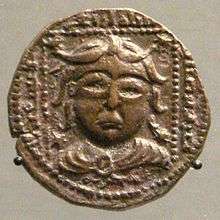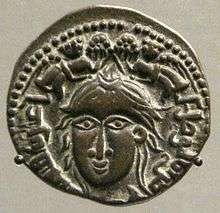Zengid dynasty
The Zengid or Zangid dynasty was a Muslim dynasty of Oghuz Turkish origin,[1] which ruled parts of the Levant and Upper Mesopotamia on behalf of the Seljuk Empire. The dynasty was founded by Imad ad-Din Zengi.
Zengid dynasty زنكيون | |||||||||||||
|---|---|---|---|---|---|---|---|---|---|---|---|---|---|
| 1127–1250 | |||||||||||||
Zengid Dynasty at its greatest extent | |||||||||||||
| Status | Vassal of the Seljuk Empire | ||||||||||||
| Capital | Aleppo | ||||||||||||
| Common languages | Oghuz Turkic Arabic | ||||||||||||
| Religion | Sunni Islam Shia Islam | ||||||||||||
| Government | Emirate | ||||||||||||
| Emir | |||||||||||||
• 1127–1146 | Imad ad-Din Zengi (first) | ||||||||||||
• 1241–1250 | Mahmud Al-Malik Al-Zahir (last reported) | ||||||||||||
| History | |||||||||||||
• Established | 1127 | ||||||||||||
• Disestablished | 1250 | ||||||||||||
| Currency | Dinar | ||||||||||||
| |||||||||||||
History
Zengi, son of Aq Sunqur al-Hajib, became the Seljuk atabeg of Mosul in 1127.[2] He quickly became the chief Turkish potentate in Northern Syria and Iraq, taking Aleppo from the squabbling Artuqids in 1128 and capturing the County of Edessa from the Crusaders after the siege of Edessa in 1144. This latter feat made Zengi a hero in the Muslim world, but he was assassinated by a slave two years later, in 1146.[3]
On Zengi's death, his territories were divided, with Mosul and his lands in Iraq going to his eldest son Saif ad-Din Ghazi I, and Aleppo and Edessa falling to his second son, Nur ad-Din, atabeg of Aleppo. Nur ad-Din proved to be as competent as his father. In 1149 he defeated Raymond of Poitiers, Prince of Antioch, at the battle of Inab, and the next year conquered the remnants of the County of Edessa west of the Euphrates.[4] In 1154 he capped off these successes by his capture of Damascus from the Burid dynasty that ruled it.[5]
Now ruling from Damascus, Nur ad-Din's success continued. Another Prince of Antioch, Raynald of Châtillon was captured, and the territories of the Principality of Antioch were greatly reduced. In the 1160s, Nur ad-Din's attention was mostly held by a competition with the King of Jerusalem, Amalric of Jerusalem, for control of the Fatimid Caliphate. Ultimately, Nur ed-Din's Kurdish general Shirkuh was successful in conquering Fatimid Egypt in 1169, but Shirkuh's nephew and successor as Governor of Egypt, Saladin, eventually rejected Nur ad-Din's control.[6]
Nur ad-Din was preparing to invade Egypt to bring Saladin under control when he unexpectedly died in 1174. His son and successor As-Salih Ismail al-Malik was only a child, and was forced to flee to Aleppo, which he ruled until 1181, when he was murdered and replaced by his brother Imad al-Din Zengi II. Saladin conquered Aleppo two years later, ending Zengid rule in Syria.
Zengid princes continued to rule in Northern Iraq well into the 13th century, ruling Mosul until 1234; their rule did not come finally to an end until 1250.
Zengid rulers


Zengid Atabegs and Emirs of Mosul
See Rulers of Mosul.
- Zengi, 1127-1146
- Sayf al-Din Ghazi I, son of Zengi, 1146-1149
- Qutb al-Din Mawdud, son of Zengi, 1149-1170
- Sayf al-Din Ghazi II, son of Qutb al-Din Mawdud, 1170-1180
- Izz al-Din Mas'ud, son of Qutb al-Din Mawdud, 1180-1193
- Nur al-Din Arslan Shah I, son of Izz al-Din Mas'ud, 1193-1211
- Izz al-Din Mas'ud II, son of Nur al-Din Arslan Shah I, 1211-1218
- Nur al-Din Arslan Shah II, son of Izz al-Din Mas'ud II, 1218-1219
- Nasir ad-Din Mahmud, son of Izz al-Din Mas'ud, 1219–1234.
Mosul was taken over by Badr al-Din Lu'lu', atabeg to Nasir ad-Din Mahmud, whom he murdered in 1234.
Zengid Emirs of Aleppo
See Rulers of Aleppo.
- Zengi, 1128-1146
- Nur al-Din, son of Zengi, 1146-1174
- As-Salih Ismail al-Malik, son of Nur al-Din, 1174-1181
- Imad al-Din Zengi II, son of Nur al-Din, 1181–1183.
Aleppo was conquered by Saladin in 1183 and ruled by Ayyubids until 1260.
Zengid Emirs of Damascus
See Rulers of Damascus.
- Nur al-Din, son of Zengi, 1154-1174
- As-Salih Ismail al-Malik, son of Nur al-Din, 1174.
Damascus was conquered by Saladin in 1174 and ruled by Ayyubids until 1260.
Zengid Emirs of Sinjar
See Sinjar, Islamic Era.
- Imad al-Din Zengi II, son of Nur al-Din, 1171-1197
- Qutb ad-Din Muhammad, son of Zengi II, 1197-1219
- Imad al-Din Shahanshah, son of Qutb ad-Din Muhammad, 1219-1220
- Jalal al-Din Mahmud (co-ruler), son of Qutb ad-Din Muhammad, 1219-1220
- Fath al-Din Umar (co-ruler), son of Qutb ad-Din Muhammad, 1219–1220.
Sinjar was taken by the Ayyubids in 1220 and ruled by al-Ashraf Musa, Ayyubid emir of Diyar Bakr. It later came under the control of Badr al-Din Lu'lu', ruler of Mosul beginning in 1234.
Zengid Emirs of al-Jazira (in Northern Iraq)
See Upper Mesopotamia, Islamic Empires.
- Mu'izz al-Din Sanjar Shah, son of Sayf al-Din Ghazi II, 1180-1208
- Mu'izz al-Din Mahmud, son of Mu'izz al-Din Sanjar Shah, 1208-1241
- Mahmud al-Malik al-Zahir, son of Mu'izz al-Din Mahmud, 1241–1250.
In 1250, al-Jazira fell under the domination of an-Nasir Yusuf, Ayyubid emir of Aleppo.
See also
- List of Emirs of Mosul
- List of Sunni Muslim dynasties
References
- Bosworth 1996, p. 191.
- Ayalon 1999, p. 166.
- Irwin 1999, p. 227.
- Hunyadi & Laszlovszky 2001, p. 28.
- Asbridge 2012, p. 1153.
- Stevenson 1907, p. 194.
Sources
- Asbridge, Thomas (2012). The Crusades: The War for the Holy Land. Simon & Schuster.CS1 maint: ref=harv (link)
- Ayalon, David (1999). Eunuchs, Caliphs and Sultans: A Study in Power Relationships. Hebrew University Magnes Press.CS1 maint: ref=harv (link)
- Bosworth, C.E. (1996). The New Islamic Dynasties: A Chronological and Genealogical Manual. New York: Columbia University Press.CS1 maint: ref=harv (link)
- Hunyadi, Zsolt; Laszlovszky, József (2001). The Crusades and the Military Orders. Central European University.CS1 maint: ref=harv (link)
- Irwin, Robert (1999). "Islam and the Crusades 1096-1699". In Riley-Smith, Jonathan (ed.). The Oxford History of the Crusades. Oxford University Press.CS1 maint: ref=harv (link)
- Stevenson, William Barron (1907). The Crusaders in the East. Cambridge University Press.CS1 maint: ref=harv (link)
- Taef El-Azharii (2006). Zengi and the Muslim Response to the Crusades, Routledge, Abington, UK.